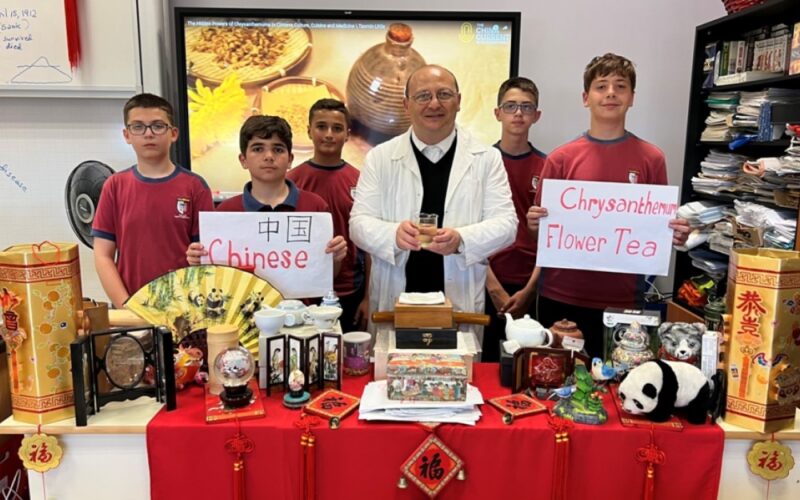A group of Form 3 (Year 9) and Form 4 (Year 10) Science China Corner students at St Margaret College Secondary School Verdala, Cospicua recently participated in a joint project about the health benefits of Chinese chrysanthemum tea.
This school project was coordinated by the senior science teacher Martin Azzopardi and was held in the Science China Corner relating it to the science study unit about Healthy Life and Plants.
A brief history
Chrysanthemum tea is a flower-based infusion beverage made from the chrysanthemum flowers of the species ‘Chrysanthemum morifolium’ or ‘Chrysanthemum indicum’, which are most popular throughout East and Southeast Asia. It was first cultivated in China in the 1500 B.C. as a herbal plant but it became popular as a tea beverage during the Song dynasty (AD960 to AD1279).
In Chinese tradition, once a pot of chrysanthemum tea has been drunk, hot water is typically added again to the flowers in the pot (producing a tea that is slightly less strong); this process is often repeated several times. To prepare the tea, chrysanthemum flowers (usually dried) are steeped in hot water (usually 90°C to 95°C after cooling from a boil) in a teapot, cup or glass. The resulting drink is transparent and ranges from pale to bright yellow in colour, with a floral aroma.

Varieties
Several varieties of chrysanthemum, ranging from white to pale or bright yellow in colour, are used for tea. These include:
- Huángshān-gòngjú (黄山贡菊, literally “Yellow Mountain tribute chrysanthemum”); also called simply gòngjú (贡菊),
- Hángbáijú (杭白菊), originating from Tongxiang, near Hangzhou; also called simply Hángjú, (杭菊),
- Chújú (滁菊), originating from the Chuzhou district of Anhui,
- Bójú (亳菊), originating in the Bozhou district of Anhui.
Of these, the first two are most popular. Some varieties feature a prominent yellow flower head while others do not.
Health benefits
The vitamins, minerals and antioxidants in chrysanthemum tea can provide important health benefits. In fact, chrysanthemum tea contains iron, which is important for growth and development and helps to carry oxygen through the blood.
In traditional Chinese medicine, chrysanthemum tea is considered to be an anti-hypertensive food, meaning it can help lower your blood pressure. Chrysanthemum tea can also help protect the liver from damage associated with processing alcohol.
The essential oils in chrysanthemum flowers have repeatedly been shown to have antibacterial and antimicrobial effects, which can help prevent the growth and spread of bacteria as well as other microorganisms.
Although relatively little of the plant’s essential oils come through in steeping tea, it may still be effective in fighting infections, especially combined with the other minerals it contains.


Chrysanthemum tea is rich in potassium, which helps reduce the risk of serious health conditions like cancer, diabetes, stroke and heart disease. It’s also a source of magnesium, phosphorus, calcium and iron.
Chrysanthemum helps release internal heat, making it ideal for those who often suffer from heat. This cooling effect helps restore balance, especially in hot climates or after consuming spicy or fried foods.
Chrysanthemum is believed to support liver function, which in turn helps relieve eye fatigue, dryness and redness. With its anti-inflammatory and antioxidant properties, chrysanthemum aids the body’s natural detox process, promoting clearer skin and overall vitality.
Chrysanthemum also works on an emotional level. It has a calming effect on the nervous system. So drinking it regularly may help reduce stress and mental agitation, promote deeper relaxation, support better sleep quality and improve mood and emotional balance.
Other herbal teas like chamomile, ginger, turmeric, feverfew and peppermint may also provide relaxing or relieving effects for migraine headaches.
However, some people suffering from various allergies to flowers may have a negative reaction to drinking chrysanthemum tea.
During this project, students watched an interesting documentary about the ‘Hidden Powers of Chrysanthemums in Chinese Culture, Cuisine and Medicine’.
This was another project held in the Science China Corner of St Margaret College which serves as a Montessori Method of teaching science. This project aims to reach three of the main goals proposed by the United Nations Sustainable Development Goals: good health and well-being, life on land and quality education.
This article was written by St Margaret College Secondary School Verdala Form 4 (Year 10) students Mark Musienko, Luke Bonnici, Luca Schembri, Ke Xu and Shania Scicluna with the help of senior science teacher Martin Azzopardi. Azzopardi and his students are grateful to the Chinese Embassy in Malta, the China Cultural Centre in Malta and the Confucius Institute at the University of Malta for their continuous encouragement and support.
For more education-reltaed articles, click here. For more Child stories, follow this link.










